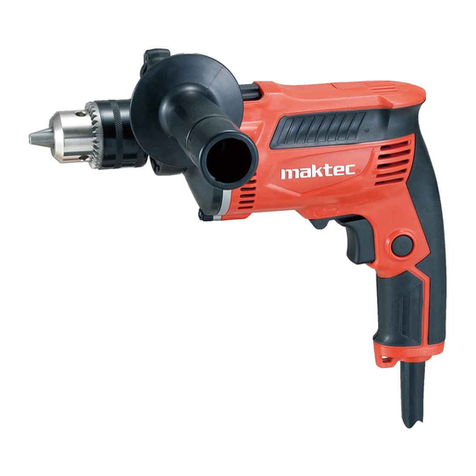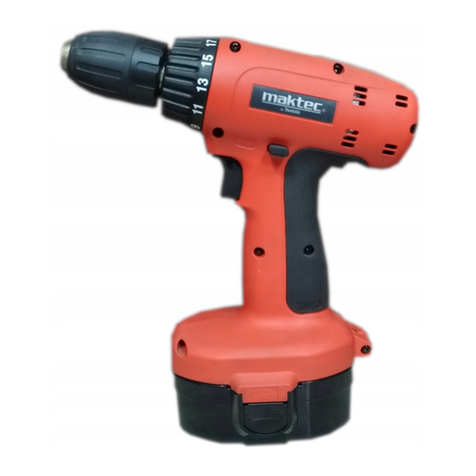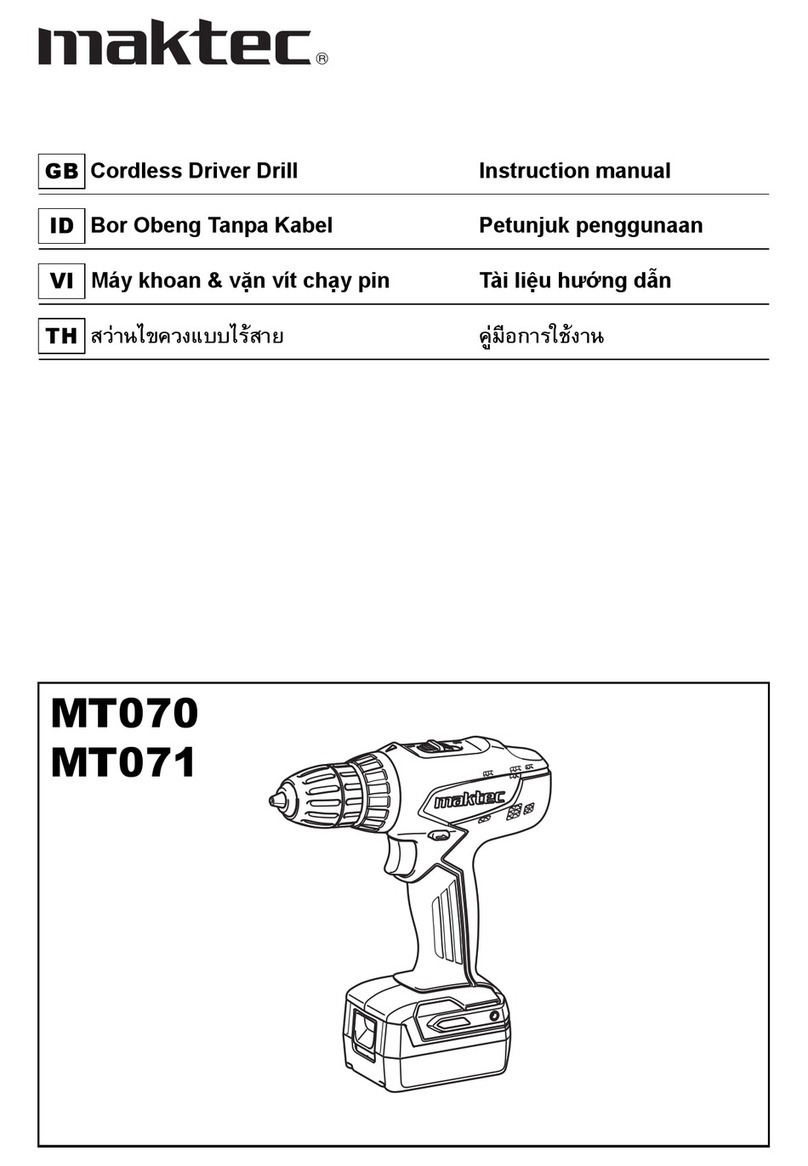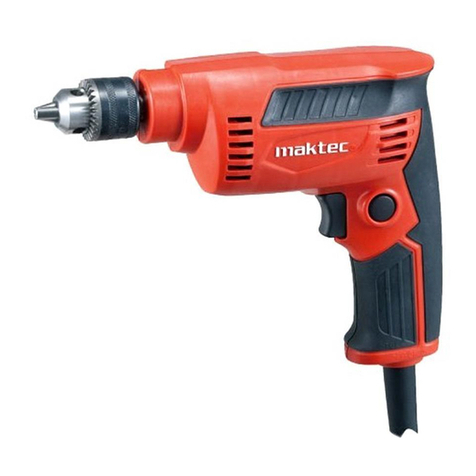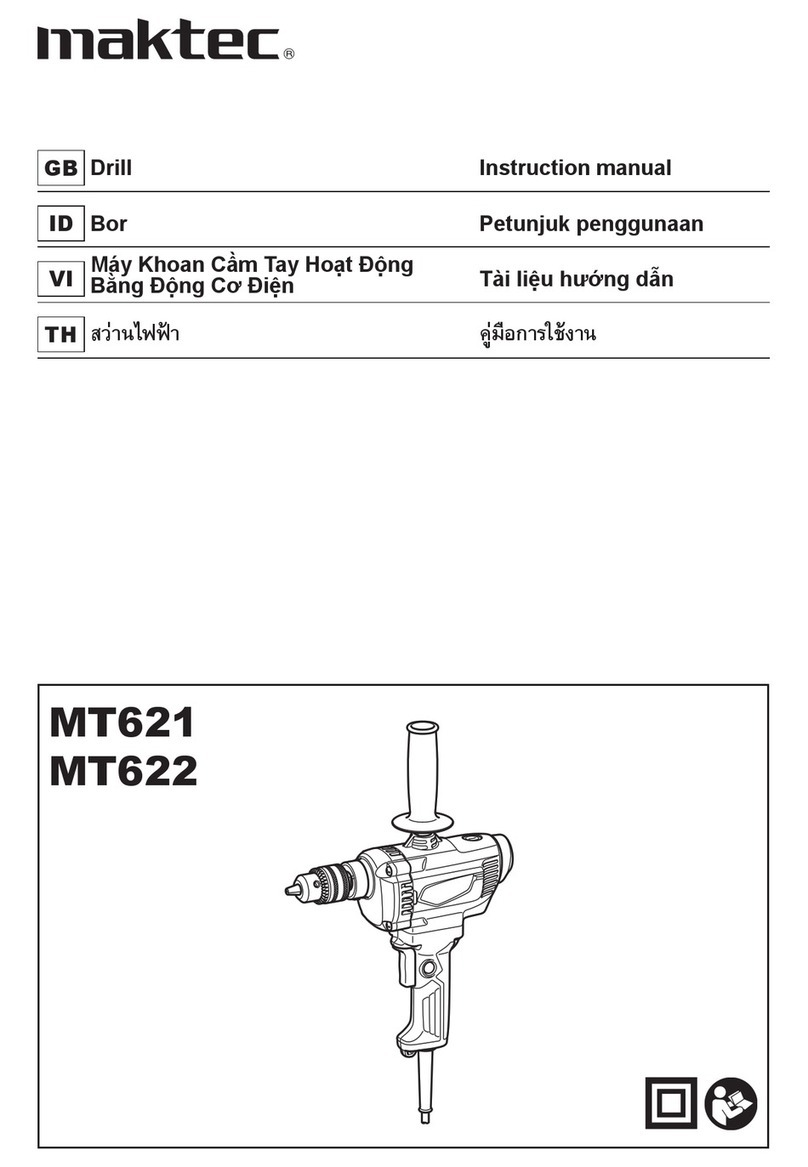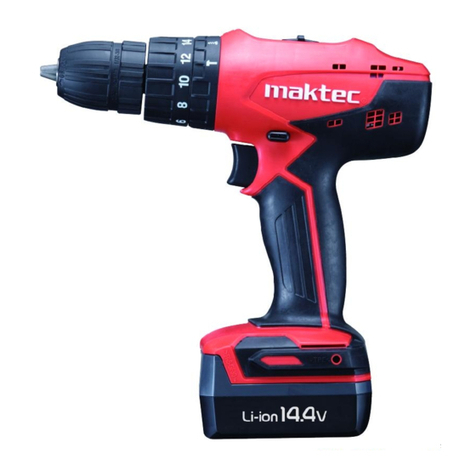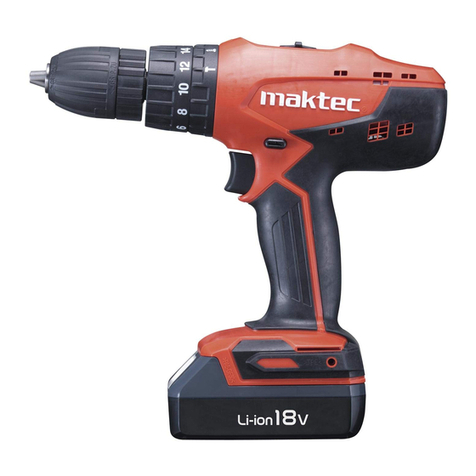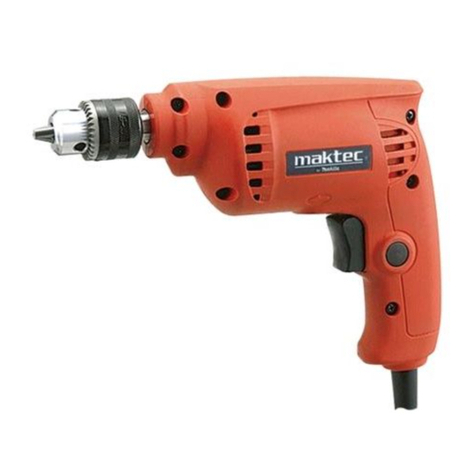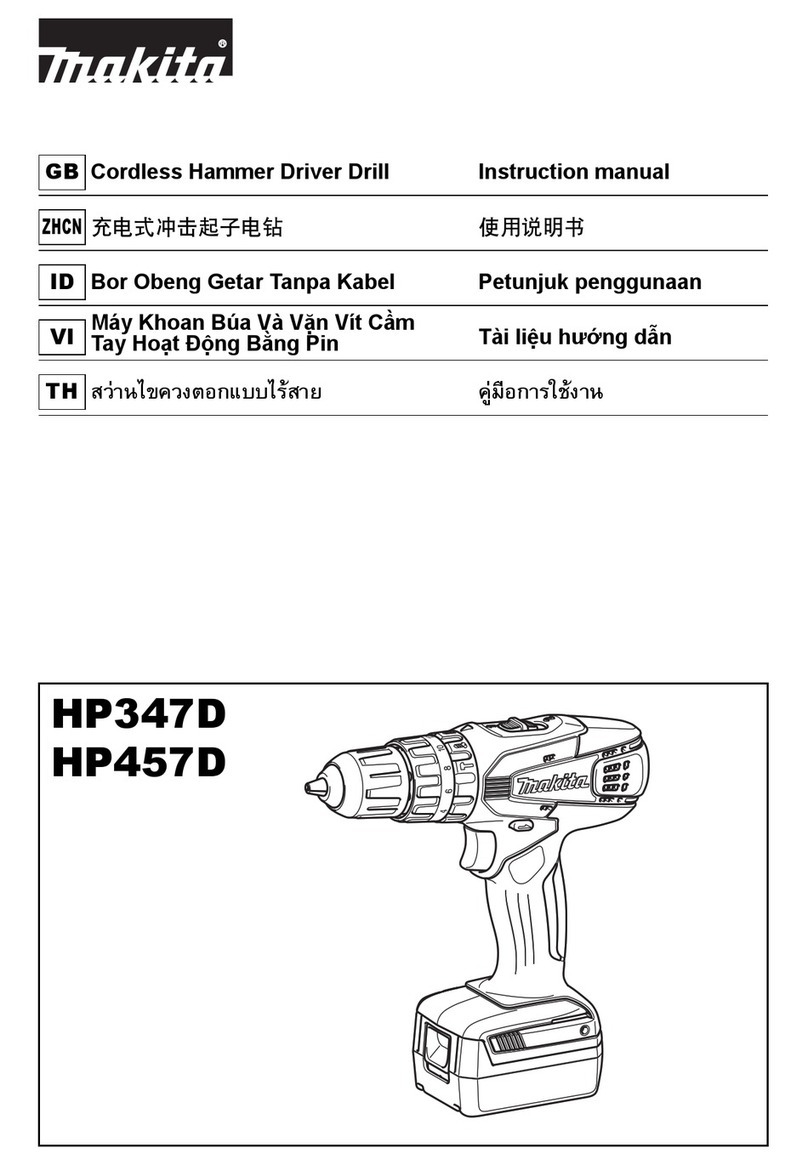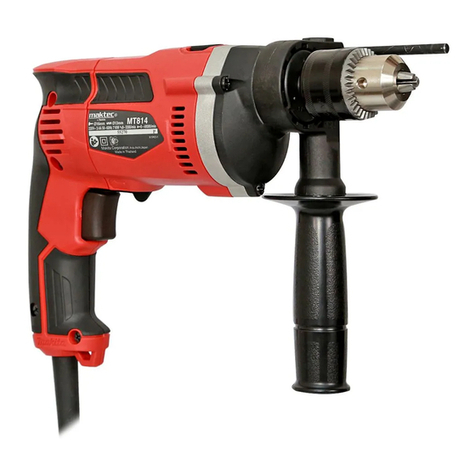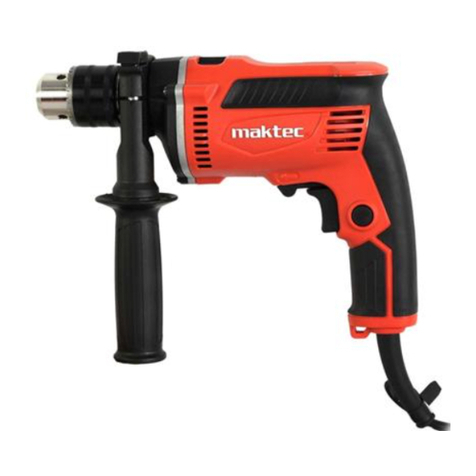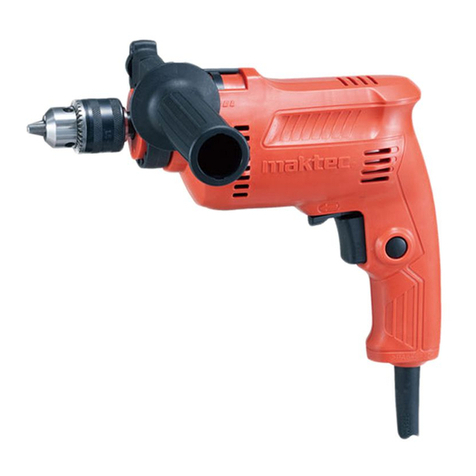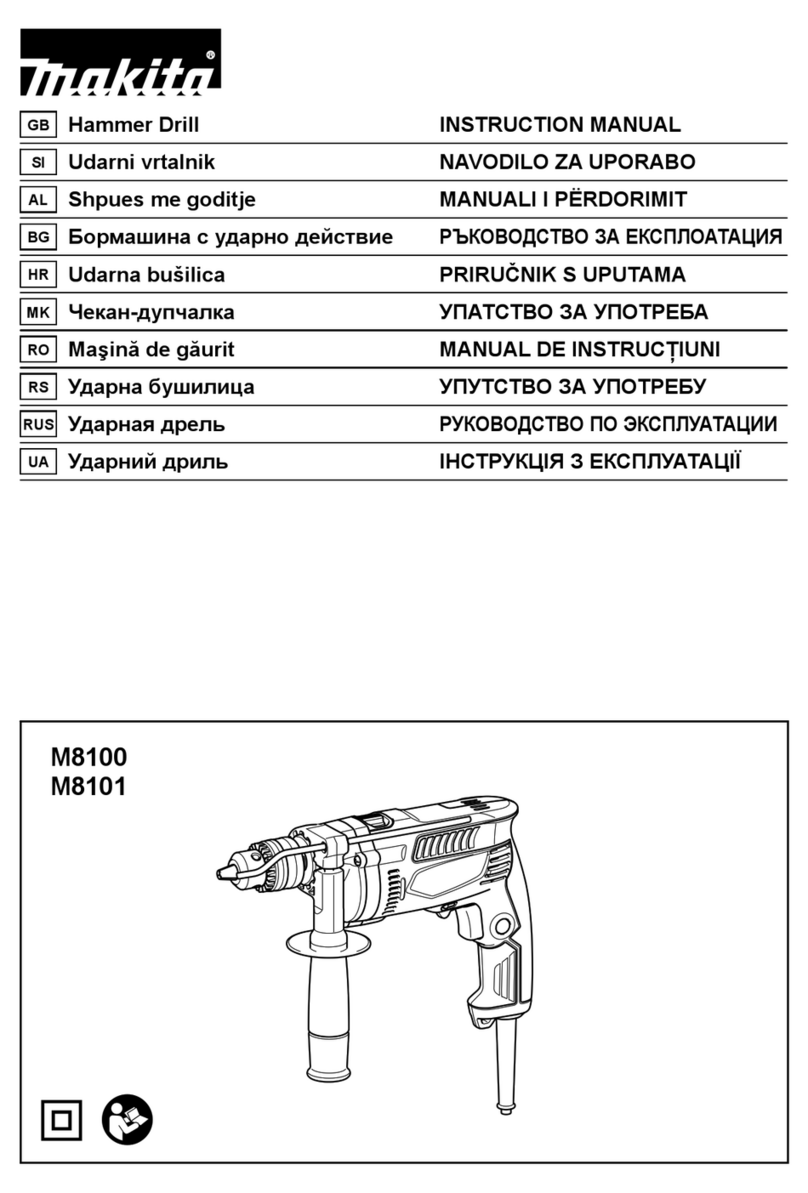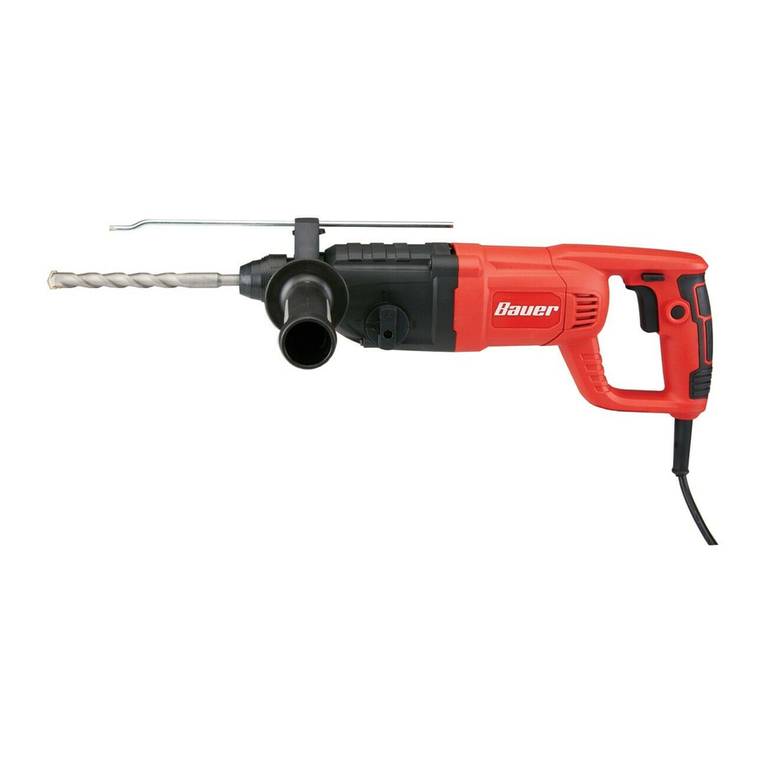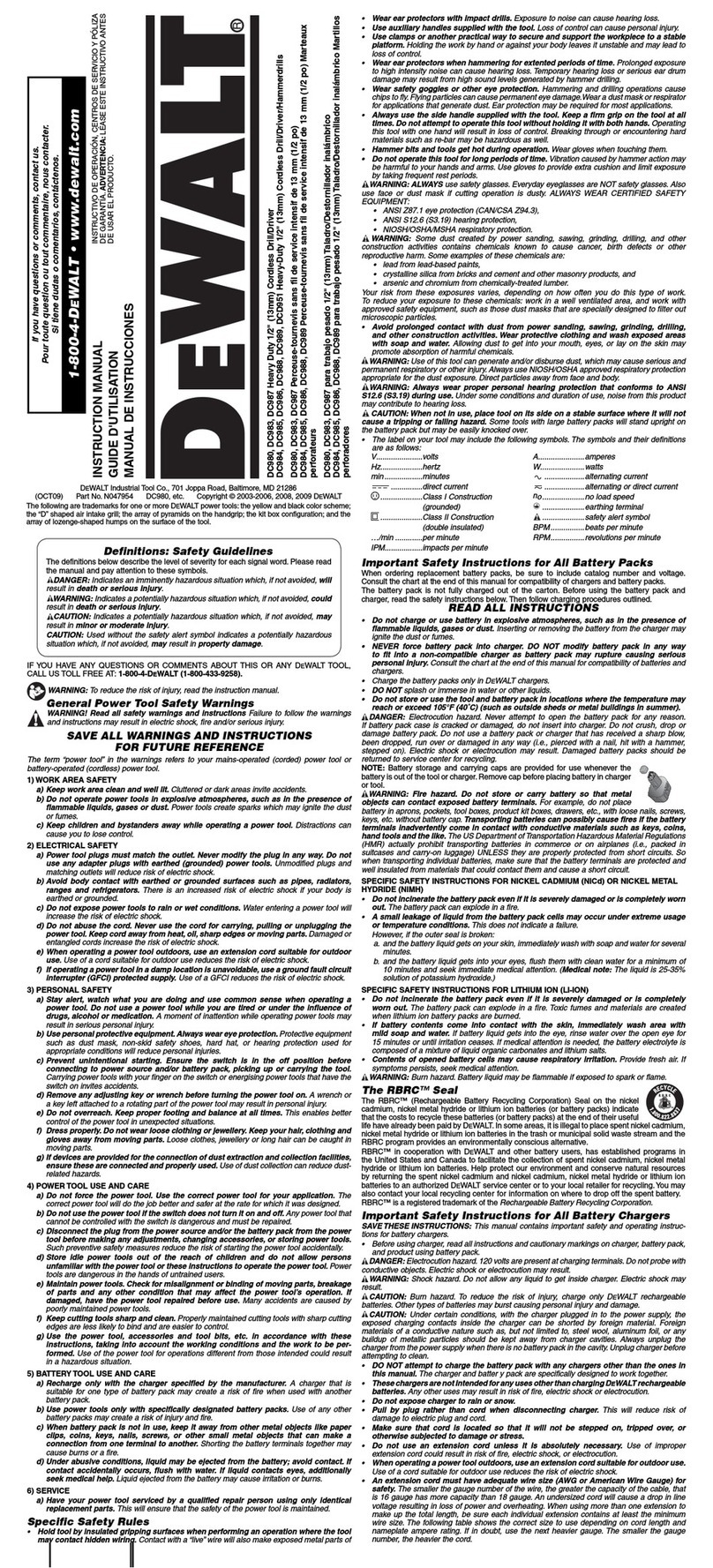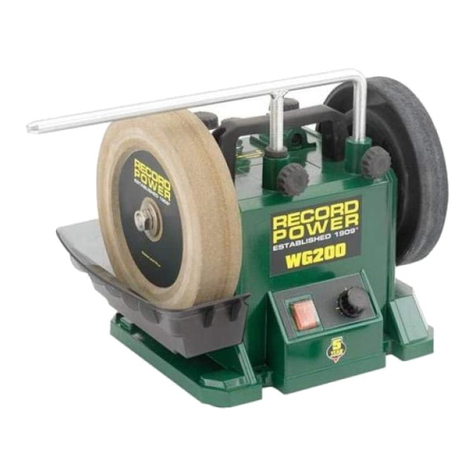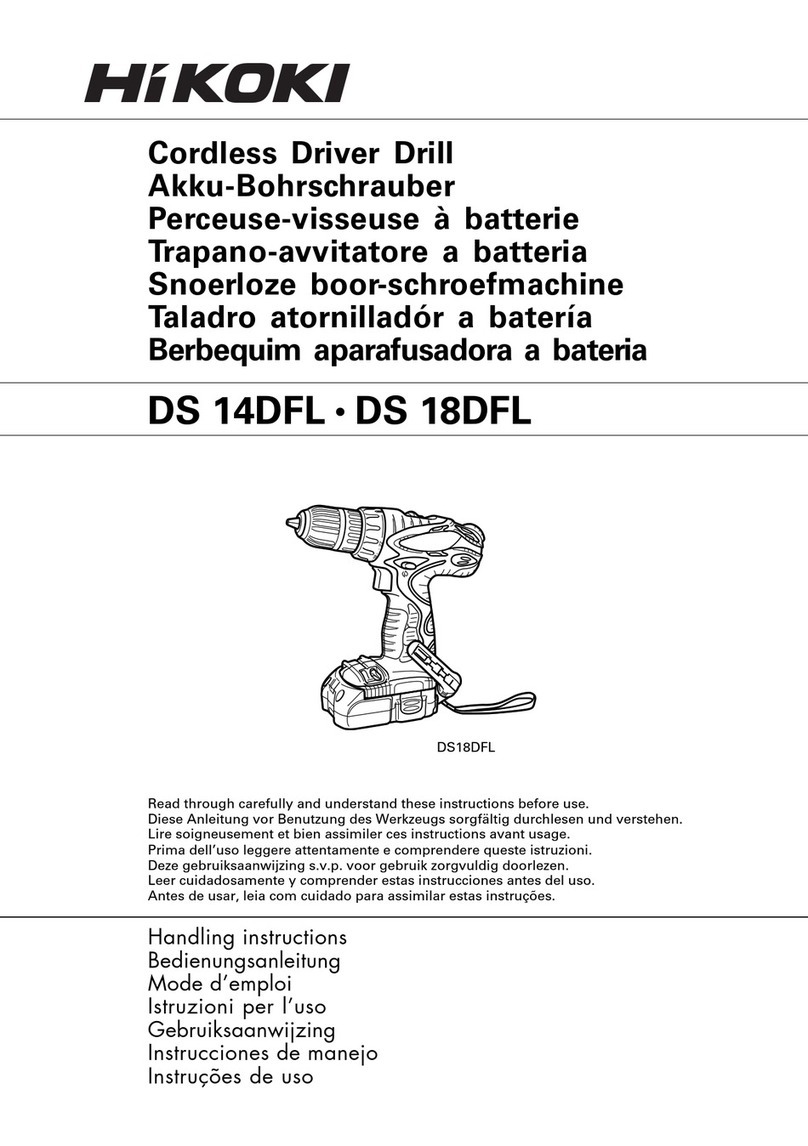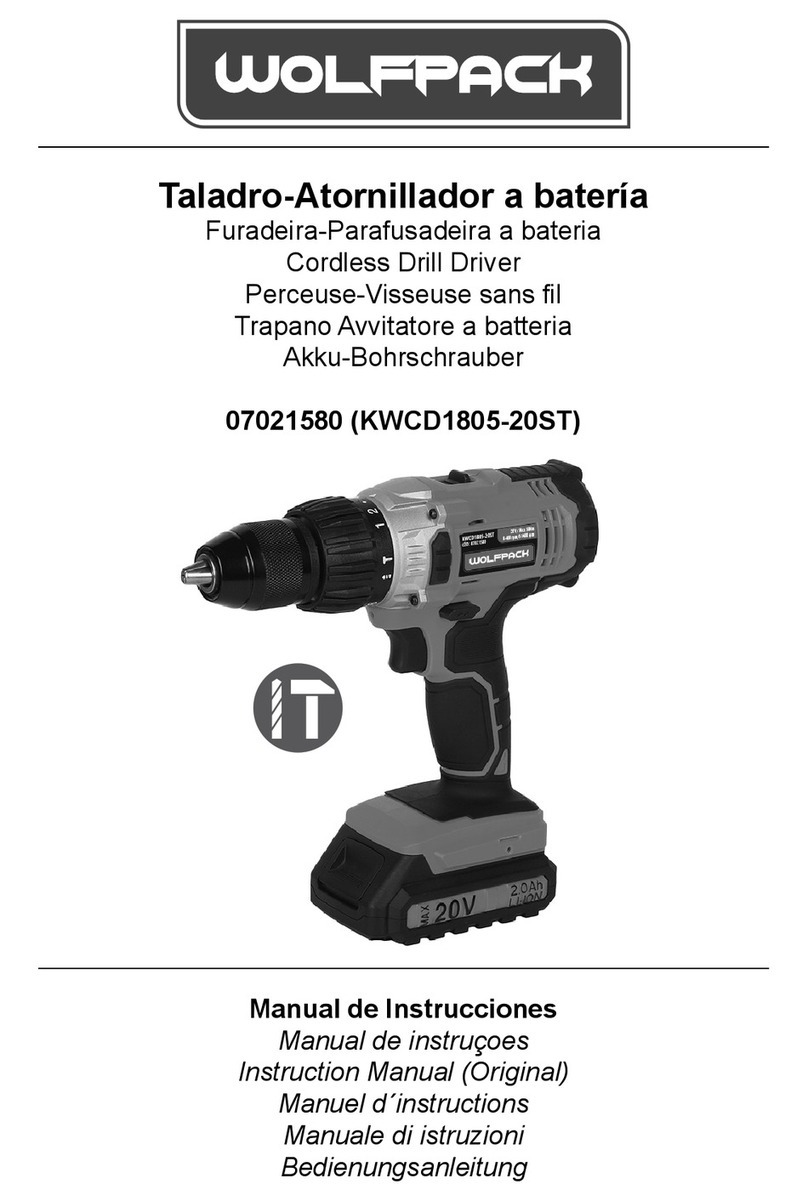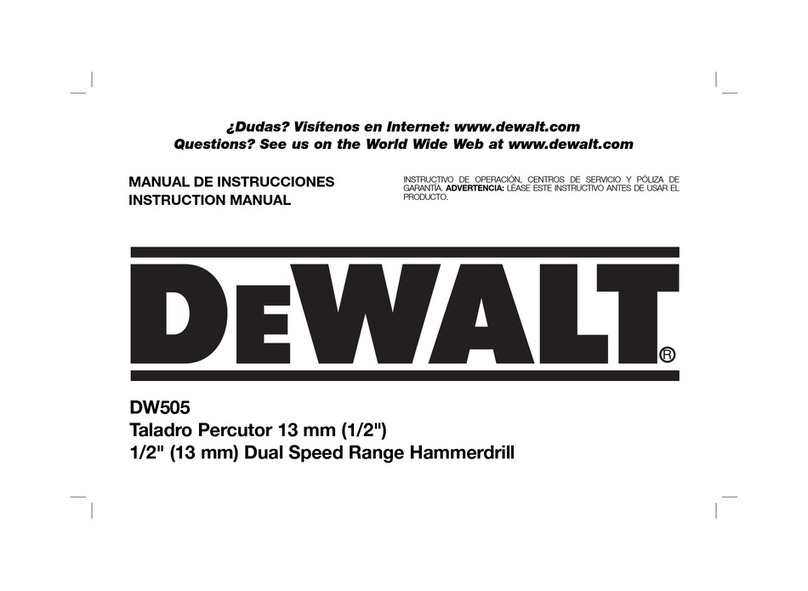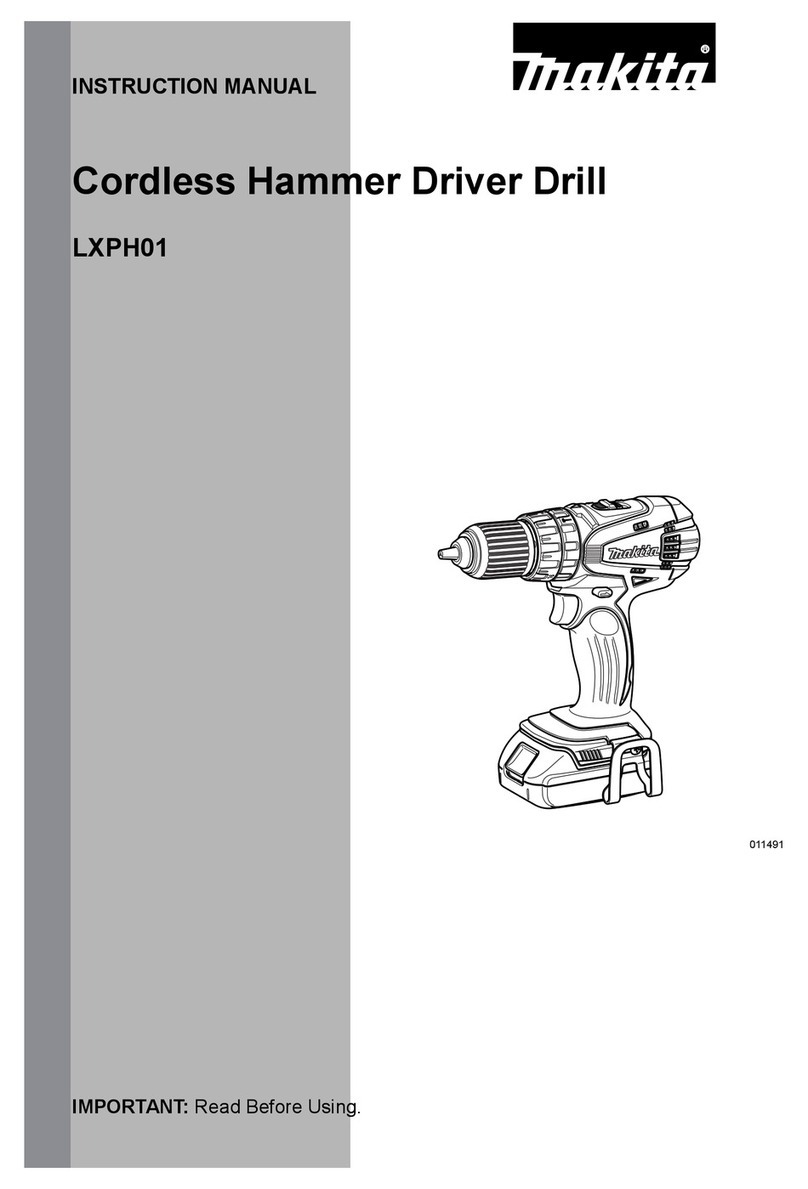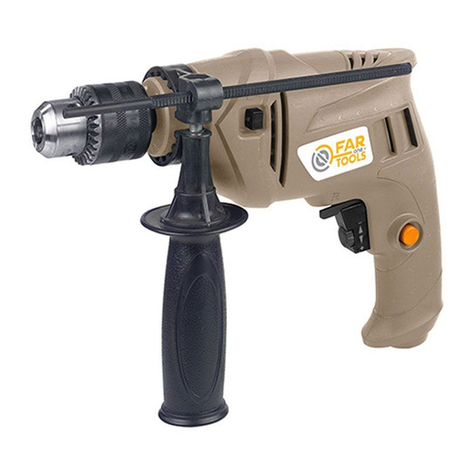Maktec MT810 User manual

GB Hammer Drill Instruction manual
ID Bor Palu Petunjuk penggunaan
VI Khoan Búa Tài liu hng dn
TH
MT810
MT811
MT812
MT813

2
1001691 2001692
3004365 4011408
5001694 6001695
7001696
1
2
3
4
56
78
9
10
11
12
1
13
14
15
16
17
18
A
B
19

3
ENGLISH
Explanation of general view
SPECIFICATIONS
• Due to our continuing programme of research and development, the specifications herein are subject to change without
notice.
•Specifications may differ from country to country.
• Weight according to EPTA-Procedure 01/2003
END201-5
Symbols
The following show the symbols used for the equipment.
Be sure that you understand their meaning before use.
..... Read instruction manual.
.............. DOUBLE INSULATION
ENE039-1
Intended use
The tool is intended for impact drilling in brick, concrete
and stone as well as for drilling without impact in wood,
metal, ceramic and plastic.
ENF002-1
Power supply
The tool should be connected only to a power supply of
the same voltage as indicated on the nameplate, and can
only be operated on single-phase AC supply. They are
double-insulated in accordance with European Standard
and can, therefore, also be used from sockets without
earth wire.
GEA005-3
General Power Tool Safety Warnings
WARNING! Read all safety warnings and all
instructions. Failure to follow the warnings and
instructions may result in electric shock, fire and/or
serious injury.
Save all warnings and instructions for future
reference.
The term “power tool” in the warnings refers to your
mains-operated (corded) power tool or battery-
operated (cordless) power tool.
Work area safety
1. Keep work area clean and well lit. Cluttered or dark
areas invite accidents.
2. Do not operate power tools in explosive atmospheres,
such as in the presence of flammable liquids, gases or
dust. Power tools create sparks which may ignite the
dust or fumes.
3. Keep children and bystanders away while operating a
power tool. Distractions can cause you to lose control.
Electrical safety
4. Power tool plugs must match the outlet. Never modify
the plug in any way. Do not use any adapter plugs with
earthed (grounded) power tools. Unmodified plugs
and matching outlets will reduce risk of electric shock.
5. Avoid body contact with earthed or grounded surfaces
such as pipes, radiators, ranges and refrigerators.
There is an increased risk of electric shock if your
body is earthed or grounded.
6. Do not expose power tools to rain or wet conditions.
Water entering a power tool will increase the risk of
electric shock.
7. Do not abuse the cord. Never use the cord for
carrying, pulling or unplugging the power tool. Keep
cord away from heat, oil, sharp edges or moving parts.
Damaged or entangled cords increase the risk of
electric shock.
1. Grip base
2. Side grip (auxiliary handle)
3. Teeth
4. Protrusion
5. Loosen
6. Tighten
7. Drill chuck
8. Chuck key
9. Sleeve
10. Ring
11. Side grip
12. Depth gauge
13. Hex washer
14. Hex bolt
15. Dot
16. Switch trigger
17. Lock button
18. Reversing switch lever
19. Action mode changing lever
Model MT810 MT811/MT812 MT813
Capacities
Concrete 10 mm 13 mm 16 mm
Wood 18 mm 18 mm 30 mm
Steel 10 mm 13 mm 13 mm
No load speed (min-1)0 - 2,800 0 - 2,800 0 - 3,000
Blows per minute 0 - 30,800 0 - 30,800 0 - 45,000
Overall length 258 mm 272 mm 297 mm
Net weight 1.6 kg 1.9 kg 2.2 kg
Safety class /II

4
8. When operating a power tool outdoors, use an
extension cord suitable for outdoor use. Use of a cord
suitable for outdoor use reduces the risk of electric
shock.
9. If operating a power tool in a damp location is
unavoidable, use a residual current device (RCD)
protected supply. Use of an RCD reduces the risk of
electric shock.
10. Use of power supply via a RCD with a rated residual
current of 30mA or less is always recommended.
Personal safety
11. Stay alert, watch what you are doing and use common
sense when operating a power tool. Do not use a
power tool while you are tired or under the influence of
drugs, alcohol or medication. A moment of inattention
while operating power tools may result in serious
personal injury.
12. Use personal protective equipment. Always wear eye
protection. Protective equipment such as dust mask,
non-skid safety shoes, hard hat, or hearing protection
used for appropriate conditions will reduce personal
injuries.
13. Prevent unintentional starting. Ensure the switch is in
the off-position before connecting to power source
and/or battery pack, picking up or carrying the tool.
Carrying power tools with your finger on the switch or
energising power tools that have the switch on invites
accidents.
14. Remove any adjusting key or wrench before turning
the power tool on. A wrench or a key left attached to a
rotating part of the power tool may result in personal
injury.
15. Do not overreach. Keep proper footing and balance at
all times. This enables better control of the power tool
in unexpected situations.
16. Dress properly. Do not wear loose clothing or
jewellery. Keep your hair, clothing, and gloves away
from moving parts. Loose clothes, jewellery or long
hair can be caught in moving parts.
17. If devices are provided for the connection of dust
extraction and collection facilities, ensure these are
connected and properly used. Use of dust collection
can reduce dust-related hazards.
Power tool use and care
18. Do not force the power tool. Use the correct power
tool for your application. The correct power tool will do
the job better and safer at the rate for which it was
designed.
19. Do not use the power tool if the switch does not turn it
on and off. Any power tool that cannot be controlled
with the switch is dangerous and must be repaired.
20. Disconnect the plug from the power source and/or the
battery pack from the power tool before making any
adjustments, changing accessories, or storing power
tools. Such preventive safety measures reduce the
risk of starting the power tool accidentally.
21. Store idle power tools out of the reach of children and
do not allow persons unfamiliar with the power tool or
these instructions to operate the power tool. Power
tools are dangerous in the hands of untrained users.
22. Maintain power tools. Check for misalignment or
binding of moving parts, breakage of parts and any
other condition that may affect the power tool's
operation. If damaged, have the power tool repaired
before use. Many accidents are caused by poorly
maintained power tools.
23. Keep cutting tools sharp and clean. Properly
maintained cutting tools with sharp cutting edges are
less likely to bind and are easier to control.
24. Use the power tool, accessories and tool bits etc. in
accordance with these instructions, taking into
account the working conditions and the work to be
performed. Use of the power tool for operations
different from those intended could result in a
hazardous situation.
Service
25. Have your power tool serviced by a qualified repair
person using only identical replacement parts. This
will ensure that the safety of the power tool is
maintained.
26. Follow instruction for lubricating and changing
accessories.
27. Keep handles dry, clean and free from oil and grease.
GEB003-5
HAMMER DRILL SAFETY
WARNINGS
1. Wear ear protectors when impact drilling. Exposure to
noise can cause hearing loss.
2. Use auxiliary handle(s), if supplied with the tool. Loss
of control can cause personal injury.
3. Hold power tool by insulated gripping surfaces, when
performing an operation where the cutting accessory
may contact hidden wiring or its own cord. Cutting
accessory contacting a “live” wire may make exposed
metal parts of the power tool “live” and could give the
operator an electric shock.
4. Always be sure you have a firm footing.
Be sure no one is below when using the tool in high
locations.
5. Hold the tool firmly with both hands.
6. Keep hands away from rotating parts.
7. Do not leave the tool running. Operate the tool only
when hand-held.
8. Do not touch the bit or the workpiece immediately after
operation; they may be extremely hot and could burn
your skin.
9. Some material contains chemicals which may be
toxic. Take caution to prevent dust inhalation and skin
contact. Follow material supplier safety data.
SAVE THESE INSTRUCTIONS.
WARNING:
DO NOT let comfort or familiarity with product (gained
from repeated use) replace strict adherence to safety
rules for the subject product. MISUSE or failure to
follow the safety rules stated in this instruction
manual may cause serious personal injury.

5
ASSEMBLY
Installing side grip (auxiliary handle)
(Fig. 1)
CAUTION:
•Always be sure that the tool is switched off and
unplugged before installing or removing the side grip.
Always use the side grip to ensure operating safety. Install
the side grip so that the teeth on the grip fit in between the
protrusions on the tool barrel. Then tighten the grip by
turning clockwise at the desired position. It may be swung
360° so as to be secured at any position.
Installing or removing drill bit
CAUTION:
•Always be sure that the tool is switched off and
unplugged before installing or removing the bit.
For Model MT810/MT811/MT813 (Fig. 2)
To install the bit, place it in the chuck as far as it will go.
Tighten the chuck by hand. Place the chuck key in each of
the three holes and tighten clockwise. Be sure to tighten
all three chuck holes evenly. To remove the bit, turn the
chuck key counterclockwise in just one hole, then loosen
the chuck by hand.
After using the chuck key, be sure to return it to the
original position.
For Model MT812 (Fig. 3)
Hold the ring and turn the sleeve counterclockwise to
open the chuck jaws. Place the bit in the chuck as far as it
will go. Hold the ring firmly and turn the sleeve clockwise
to tighten the chuck.
To remove the bit, hold the ring and turn the sleeve
counterclockwise.
Depth gauge (optional accessory) (Fig. 4)
The depth gauge is convenient for drilling holes of uniform
depth. Install the depth gauge by the following sequence.
1. Turn the side grip counterclockwise to loosen the hex
bolt fully and pull it out.
2. Insert the hex bolt into the hole of the hex washer from
the side of the hex washer with a dot.
3. Insert the hex bolt into the side grip through the grip
base.
4. Slightly tighten the side grip.
5. Insert the depth gauge and adjust the depth of hole.
6. Turn the side grip clockwise so that the depth gauge
and the grip base are fixed on the tool completely.
NOTE:
• The depth gauge cannot be used at the position where
the depth gauge strikes against the gear housing.
FUNCTIONAL DESCRIPTION
Switch action (Fig. 5)
CAUTION:
• Before plugging in the tool, always check to see that
the switch trigger actuates properly and returns to the
“OFF” position when released.
To start the tool, simply pull the switch trigger. Tool speed
is increased by increasing pressure on the switch trigger.
Release the switch trigger to stop. For continuous
operation, pull the switch trigger and then push in the lock
button. To stop the tool from the locked position, pull the
switch trigger fully, then release it.
Reversing switch action (Fig. 6)
This tool has a reversing switch to change the direction of
rotation. Move the reversing switch lever to the position
(A side) for clockwise rotation or to the position (B side)
for counterclockwise rotation.
CAUTION:
•Always check the direction of rotation before operation.
• Use the reversing switch only after the tool comes to a
complete stop. Changing the direction of rotation
before the tool stops may damage the tool.
Selecting the action mode (Fig. 7)
This tool has an action mode change lever. For rotation
with hammering, slide the action mode change lever to
the right ( symbol). For rotation only, slide the action
mode change lever to the left ( symbol).
CAUTION:
• Always slide the action mode change lever all the way
to your desired mode position. If you operate the tool
with the lever positioned halfway between the mode
symbols, the tool may be damaged.
OPERATION
Hammer drilling operation
When drilling in concrete, granite, tile, etc., slide the action
mode change lever to the position of symbol to use
“rotation with hammering” action. Be sure to use a
tungsten-carbide tipped bit. Do not apply more pressure
when the hole becomes clogged with chips or particles.
Instead, run the tool at an idle, then remove the bit
partially from the hole. By repeating this several times, the
hole will be cleaned out.
After drilling the hole, use the blow-out bulb to clean the
dust out of the hole.
Drilling operation
When drilling in wood, metal or plastic materials, slide the
action mode change lever to the position of symbol to
use “rotation only” action.
Drilling in wood
When drilling in wood, the best results are obtained with
wood drills equipped with a guide screw. The guide screw
makes drilling easier by pulling the bit into the workplace.
Drilling in metal
To prevent the bit from slipping when starting a hole, make
an indentation with a center-punch and hammer at the
point to be drilled. Place the point of the bit in the
indentation and start drilling. Use a cutting lubricant when
drilling metals. The exceptions are iron and brass which
should be drilled dry.
CAUTION:
• Pressing excessively on the tool will not speed up the
drilling. In fact, this excessive pressure will only serve
to damage the tip of your bit, decrease the tool
performance and shorten the service life of the tool.

6
• There is a tremendous force exerted on the tool/bit at
the time of hole break through. Hold the tool firmly and
exert care when the bit begins to break through the
workplace.
• A stuck bit can be removed simply by setting the
reversing switch to reverse rotation in order to back
out. However, the tool may back out abruptly if you do
not hold it firmly.
• Always secure small workplaces in a vise or similar
hold-down device.
MAINTENANCE
CAUTION:
•Always be sure that the tool is switched off and
unplugged before carrying out any work on the tool.
•Never use gasoline, benzine, thinner, alcohol or the
like. Discoloration, deformation or cracks may result.
To maintain product safety and reliability, repairs,
maintenance or adjustment should be carried out by an
Makita Authorized Service Center.

7
BAHASA INDONESIA
Penjelasan tampilan keseluruhan
SPESIFIKASI
• Karena kesinambungan program penelitian dan pengembangan kami, spesifikasi yang disebutkan di sini dapat
berubah tanpa pemberitahuan.
• Spesifikasi dapat berbeda dari satu negara ke negara lainnya.
•Berat menurut Prosedur EPTA 01/2003
END201-5
Simbol
Berikut ini adalah simbol-simbol yang digunakan pada
peralatan ini.
Pastikan Anda mengerti makna masing-masing simbol
sebelum menggunakan alat.
..... Baca petunjuk penggunaan.
.............. ISOLASI GANDA
ENE039-1
Penggunaan
Mesin ini digunakan untuk membor kejut batu bata, beton
dan batu serta juga untuk membor tanpa kejut kayu,
logam, keramik dan plastik.
ENF002-1
Pasokan daya
Mesin harus terhubung dengan pasokan daya listrik yang
bervoltase sama dengan yang tertera pada pelat nama,
dan hanya dapat dijalankan dengan listrik AC fase tunggal.
Mesin diisolasi ganda sesuai Standard Eropa dan oleh
sebab itu dapat dihubungkan dengan soket tanpa arde.
GEA005-3
Peringatan Keselamatan Umum Mesin
Listrik
PERINGATAN! Bacalah semua peringatan
keselamatan dan semua petunjuk. Kelalaian
mematuhi peringatan dan petunjuk dapat
menyebabkan sengatan listrik, kebakaran dan/atau
cedera serius.
Simpanlah semua peringatan dan petunjuk untuk
acuan di masa depan.
Istilah "mesin listrik" dalam semua peringatan
mengacu pada mesin listrik yang dijalankan dengan
sumber listrik jala-jala (berkabel) atau baterai (tanpa
kabel).
Keselamatan tempat kerja
1. Jaga tempat kerja selalu bersih dan berpenerangan
cukup. Tempat kerja yang berantakan dan gelap
mengundang kecelakaan.
2. Jangan gunakan mesin listrik dalam lingkungan yang
mudah meledak, misalnya jika ada cairan, gas, atau
debu yang mudah menyala. Mesin listrik menimbulkan
bunga api yang dapat menyalakan debu atau uap
tersebut.
3. Jauhkan anak-anak dan orang lain saat
menggunakan mesin listrik. Bila perhatian terpecah,
anda dapat kehilangan kendali.
Keamanan kelistrikan
4. Steker mesin listrik harus cocok dengan stopkontak.
Jangan sekali-kali mengubah steker dengan cara apa
pun. Jangan menggunakan steker adaptor dengan
mesin listrik berarde (dibumikan). Steker yang tidak
diubah dan stopkontak yang cocok akan mengurangi
risiko sengatan listrik.
5. Hindari sentuhan tubuh dengan permukaan berarde
atau yang dibumikan seperti pipa, radiator, kompor,
dan kulkas. Risiko sengatan listrik bertambah jika
tubuh Anda terbumikan atau terarde.
1. Alas gagang
2.
Gagang sisi (pegangan tambahan)
3. Gigi-gigi
4. Tonjolan
5. Kendurkan
6. Kencangkan
7. Cuk bor
8. Kunci cuk
9. Selongsong
10. Cincin
11. Gagang sisi
12. Pengukur kedalaman
13. Cincin segi-enam
14. Baut kepala segi-enam
15. Titik
16. Saklar pemicu
17. Tombol kunci
18. Tuas saklar pengganti arah
19. Tuas pengganti sistem kerja
Model MT810 MT811/MT812 MT813
Kapasitas
Beton 10 mm 13 mm 16 mm
Baja 18 mm 18 mm 30 mm
Kayu 10 mm 13 mm 13 mm
Kecepatan tanpa beban (min-1)0 - 2,800 0 - 2,800 0 - 3,000
Hembusan per menit 0 - 30,800 0 - 30,800 0 - 45,000
Panjang keseluruhan 258 mm 272 mm 297 mm
Berat bersih 1.6 kg 1.9 kg 2.2 kg
Kelas keamanan /II

8
6. Jangan membiarkan mesin listrik kehujanan atau
kebasahan. Air yang masuk ke dalam mesin listrik
akan meningkatkan risiko sengatan listrik.
7. Jangan menyalahgunakan kabel. Jangan sekali-kali
menggunakan kabel untuk membawa, menarik, atau
mencabut mesin listrik dari stopkontak. Jauhkan kabel
dari panas, minyak, tepian tajam, atau bagian yang
bergerak. Kabel yang rusak atau kusut memperbesar
risiko sengatan listrik.
8. Bila menggunakan mesin listrik di luar ruangan,
gunakan kabel ekstensi yang sesuai untuk
penggunaan di luar ruangan. Penggunaan kabel yang
sesuai untuk penggunaan luar ruangan mengurangi
risiko sengatan listrik.
9. Jika mengoperasikan mesin listrik di lokasi lembap
tidak terhindarkan, gunakan pasokan daya yang
dilindungi peranti imbasan arus (residual current
device - RCD). Penggunaan RCD mengurangi risiko
sengatan listrik.
10. Penggunaan pasokan daya melalui RCD dengan
kapasitas arus sisa 30 mA atau kurang selalu
dianjurkan.
Keselamatan diri
11. Jaga kewaspadaan, perhatikan pekerjaan Anda dan
gunakan akal sehat bila menggunakan mesin listrik.
Jangan menggunakan mesin listrik saat Anda lelah
atau di bawah pengaruh obat bius, alkohol, atau obat.
Sekejap saja lalai saat menggunakan mesin listrik
dapat menyebabkan cedera diri yang serius.
12. Gunakan alat pelindung diri. Selalu gunakan
pelindung mata. Peralatan pelindung seperti masker
debu, sepatu pengaman anti-selip, helm pengaman,
atau pelindung telinga yang digunakan untuk kondisi
yang sesuai akan mengurangi risiko cedera diri.
13. Cegah penyalaan yang tidak disengaja. Pastikan
bahwa sakelar berada dalam posisi mati (off) sebelum
menghubungkan mesin ke sumber daya dan/atau
baterai, atau mengangkat atau membawanya.
Membawa mesin listrik dengan jari Anda pada
sakelarnya atau mengalirkan listrik pada mesin listrik
yang sakelarnya hidup (on) akan mengundang
kecelakaan.
14. Lepaskan kunci-kunci penyetel sebelum
menghidupkan mesin listrik. Kunci-kunci yang masih
terpasang pada bagian mesin listrik yang berputar
dapat menyebabkan cedera.
15. Jangan meraih terlalu jauh. Jagalah pijakan dan
keseimbangan sepanjang waktu. Hal ini
memungkinkan kendali yang lebih baik atas mesin
listrik dalam situasi yang tidak diharapkan.
16. Kenakan pakaian dengan baik. Jangan memakai
pakaian yang kedodoran atau perhiasan. Jaga jarak
antara rambut, pakaian, dan sarung tangan Anda
dengan bagian mesin yang bergerak. Pakaian
kedodoran, perhiasan, atau rambut panjang dapat
tersangkut pada bagian yang bergerak.
17. Jika tersedia fasilitas untuk menghisap dan
mengumpulkan debu, pastikan fasilitas tersebut
terhubung listrik dan digunakan dengan baik.
Penggunaan pembersih debu dapat mengurangi
bahaya yang terkait dengan debu.
Penggunaan dan pemeliharaan mesin
listrik
18. Jangan memaksa mesin listrik. Gunakan mesin listrik
yang tepat untuk keperluan Anda. Mesin listrik yang
tepat akan menuntaskan pekerjaan dengan lebih baik
dan aman pada kecepatan sesuai rancangannya.
19. Jangan gunakan mesin listrik jika sakelar tidak dapat
menyalakan dan mematikannya. Mesin listrik yang
tidak dapat dikendalikan dengan sakelarnya adalah
berbahaya dan harus diperbaiki.
20. Cabut steker dari sumber listrik dan/atau baterai dari
mesin listrik sebelum melakukan penyetelan,
penggantian aksesori, atau menyimpan mesin listrik.
Langkah keselamatan preventif tersebut mengurangi
risiko hidupnya mesin secara tak sengaja.
21. Simpan mesin listrik jauh dari jangkauan anak-anak
dan jangan biarkan orang yang tidak paham
mengenai mesin listrik tersebut atau petunjuk ini
menggunakan mesin listrik. Mesin listrik sangat
berbahaya di tangan pengguna yang tak terlatih.
22. Rawatlah mesin listrik. Periksa apakah ada bagian
bergerak yang tidak lurus atau macet, bagian yang
pecah dan kondisi lain yang dapat mempengaruhi
penggunaan mesin listrik. Jika rusak, perbaiki dahulu
mesin listrik sebelum digunakan. Banyak kecelakaan
disebabkan oleh kurangnya pemeliharaan mesin
listrik.
23. Jaga agar mesin pemotong tetap tajam dan bersih.
Mesin pemotong yang terawat baik dengan mata
pemotong yang tajam tidak mudah macet dan lebih
mudah dikendalikan.
24. Gunakan mesin listrik, aksesori, dan mata mesin, dll.
sesuai dengan petunjuk ini, dengan memperhitungkan
kondisi kerja dan jenis pekerjaan yang dilakukan.
Penggunaan mesin listrik untuk penggunaan yang lain
dari peruntukan dapat menimbulkan situasi
berbahaya.
Servis
25. Berikan mesin listrik untuk diperbaiki hanya kepada
oleh teknisi yang berkualifikasi dengan menggunakan
hanya suku cadang pengganti yang serupa. Hal ini
akan menjamin terjaganya keamanan mesin listrik.
26. Patuhi petunjuk pelumasan dan penggantian aksesori.
27. Jagalah agar gagang kering, bersih, dan bebas dari
minyak dan gemuk.
GEB003-5
PERINGATAN KESELAMATAN
BOR PALU
1.
Kenakan pelindung telinga saat melakukan pengeboran
tumbuk (impact drilling). Terpaan kebisingan dapat
menyebabkan hilangnya pendengaran.
2. Gunakan gagang tambahan, jika disertakan bersama
mesin ini. Kehilangan kendali dapat menyebabkan
cedera.
3. Pegang mesin listrik pada permukaan genggam yang
terisolasi saat melakukan pekerjaan bila mesin
pemotong mungkin bersentuhan dengan kawat
tersembunyi atau kabelnya sendiri. Aksesori
pemotong yang menyentuh kawat "hidup" dapat
menyebabkan bagian logam pada mesin teraliri arus
listrik dan menyengat pengguna.

9
4. Selalu pastikan Anda berdiri di atas alas yang kuat.
Pastikan tidak ada orang di bawahnya bila Anda
menggunakan mesin di tempat tinggi.
5. Pegang mesin kuat-kuat dengan kedua tangan.
6. Jauhkan tangan dari bagian yang berputar.
7. Jangan tinggalkan mesin dalam keadaan hidup.
Jalankan mesin hanya ketika digenggam tangan.
8. Jangan menyentuh mata mesin atau benda kerja
segera setelah pengoperasian; suhunya mungkin
masih sangat panas dan dapat membakar kulit Anda.
9. Bahan tertentu mengandung zat kimia yang mungkin
beracun. Hindari menghirup debu dan persentuhan
dengan kulit. Ikuti data keselamatan bahan dari
pemasok.
SIMPAN PETUNJUK INI.
PERINGATAN:
JANGAN biarkan kenyamanan atau terbiasanya Anda
dengan produk (karena penggunaan berulang)
menggantikan kepatuhan yang ketat terhadap aturan
keselamatan untuk produk yang terkait.
PENYALAHGUNAAN atau kelalaian mematuhi kaidah
keselamatan yang tertera dalam petunjuk ini dapat
menyebabkan cedera badan serius.
PERAKITAN
Cara memasang gagang sisi (pegangan
tambahan) (Gb. 1)
PERHATIAN:
• Pastikan mesin dalam keadaan mati dan steker telah
dicabut sebelum memasang atau melepas gagang sisi.
Gunakan selalu gagang sisi untuk menjamin keselamatan
penggunaan. Pasang gagang sisi sedemikian rupa
hingga gigi-gigi pada gagang bertemu dengan tonjolan
pada silinder mesin. Lalu kencangkan gagang dengan
memutar searah jarum jam ke posisi yang diinginkan.
Gagang dapat diputar 360° agar dapat ditahan di posisi
mana saja.
Memasang atau melepas mata bor
PERHATIAN:
• Pastikan mesin dalam keadaan mati dan steker telah
dicabut, sebelum memasang atau melepas mata bor.
Untuk Model MT810/MT811/MT813 (Gb. 2)
Untuk memasang mata bor, masukkan mata bor ke dalam
cekam sedalam mungkin. Kencangkan cekam dengan
tangan. Masukkan kunci cuk ke dalam tiga lubang yang
ada dan kencangkan searah jarum jam. Pastikan ketiga
lubang cekam dikencangkan secara seragam. Untuk
melepas mata bor, putar kunci cekam berlawanan arah
jarum jam pada satu lubang saja, lalu bebaskan mata bor
dengan tangan.
Setelah menggunakan kunci cekam, pastikan untuk
mengembalikannya ke posisi semula.
Untuk Model MT812 (Gb. 3)
Tahan cincin dan putar selongsong berlawanan arah
jarum jam untuk membuka rahang cekam. Masukkan
mata bor ke dalam cuk sejauh mungkin. Pegang cincin
dengan kuat dan putar selongsong searah jarum jam
untuk mengencangkan cekam.
Untuk melepas mata bor, pegang cincin dan putar
selongsong berlawanan arah jarum jam.
Pengukur kedalaman (pilihan aksesori)
(Gb. 4)
Pengukur kedalaman sangat tepat digunakan untuk
menghasilkan lubang-lubang pengeboran dengan
kedalaman yang seragam. Pasang pengukur kedalaman
dengan mengikuti urutan berikut ini.
1. Putar gagang sisi berlawanan arah jarum jam untuk
mengendurkan baut kepala segi-enam sepenuhnya
dan kemudian tarik.
2. Masukkan baut kepala segi-enam ke dalam lubang
cincin segi-enam dari sisi cincin segi-enam yang
bertanda titik.
3. Masukkan baut kepala segi-enam ke dalam gagang
sisi melalui alas gagang.
4. Kencangkan gagang sisi sedikit.
5. Masukkan pengukur kedalaman dan setel kedalaman
lubang.
6. Putar gagang sisi searah jarum jam sehingga
pengukur kedalaman dan alas gagang benar-benar
terpasang erat pada mesin.
CATATAN:
• Pengukur kedalaman tidak bisa digunakan bila
posisinya berlawanan dengan rumahan gir.
DESKRIPSI FUNGSI
Kerja saklar (Gb. 5)
PERHATIAN:
• Sebelum memasukkan steker, pastikan saklar
berfungsi dengan baik dan kembali ke posisi "OFF"
saat dilepas.
Untuk menyalakan mesin cukup tarik picu saklar.
Kecepatan mesin akan meningkat dengan menambah
tekanan pada picu saklar. Lepaskan picu saklar untuk
menghentikannya. Untuk penggunaan terus menerus,
tarik picu saklar lalu tekan tombol kunci. Untuk
membebaskan posisi terkunci, tarik picu saklar sampai
penuh, lalu lepaskan.
Kerja saklar pembalik arah (Gb. 6)
Mesin ini memiliki saklar pembalik arah untuk mengubah
arah putaran. Gerakkan tuas saklar pembalik arah ke
posisi (sisi A) untuk putaran searah jarum jam atau ke
posisi (sisi B) untuk putaran berlawanan arah jarum
jam.
PERHATIAN:
• Selalu periksa arah putaran sebelum pengoperasian.
• Gunakan saklar pembalik arah hanya setelah mesin
benar-benar berhenti. Mengubah arah putaran
sebelum mesin berhenti akan merusak alat.

10
Memilih mode kerja (Gb. 7)
Mesin ini memiliki tuas pengubah mode kerja. Untuk
putaran dengan getar, geser tuas pengubah mode kerja
ke kanan (simbol ). Untuk putaran saja, geser tuas
pengganti mode kerja ke kiri (simbol )
PERHATIAN:
• Selalu geser tuas pengubah sistem kerja hingga penuh
ke posisi yang anda inginkan. Jika anda memakai alat
dengan tuas berada di posisi tengah antara kedua
simbol mode alat bisa rusak.
PENGGUNAAN
Cara pengoperasian bor getar
Saat mengebor beton, granit, ubin, dl. geser tuas
pengganti mode kerja ke posisi bersimbol untuk
gerakan putar dengan getaran. Pastikan Anda
menggunakan mata bor berujung tungsten-carbide.
Jangan menambah tekanan bila lubang dipenuhi geram-
geram atau partikel. Tetapi, nyalakan alat tanpa putaran,
lalu angkat mata bor sedikit dari lubang. Dengan
mengulanginya beberapa kali, lubang akan bersih.
Setelah mengebor lubang, gunakan penghembus angin
untuk membersihkan lubang dari debu.
Pekerjaan pengeboran
Bila mengebor bahan kayu, logam atau plastik, geser tuas
pengubah mode kerja ke posisi bersimbol untuk
menggunakan hanya "putaran saja".
Mengebor kayu
Bila mengebor kayu, hasil terbaik didapat dengan mata
bor kayu yang dilengkapi sekrup pemandu. Sekrup
pemandu memudahkan pengeboran dengan menarik
mata bor ke benda kerja.
Mengebor logam
Untuk mencegah mata bor selip ketika mulai membuat
lubang, buatlah takik dengan penitik lalu palu pada titik
yang akan dilubangi. Letakkan ujung mata bor pada takik
dan mulailah membor. Gunakan cairan pendingin saat
mengebor logam. Pengecualian untuk besi dan kuningan
yang harus dibor kering.
PERHATIAN:
• Menekan mesin secara berlebihan tidak akan
mempercepat pengeboran. Bahkan, tekanan yang
berlebihan hanya akan merusak mata bor Anda,
mengurangi kinerja mesin dan memperpendek usia
mesin.
• Akan timbul gaya yang sangat kuat pada mesin/mata
bor saat menembus lubang. Pegang mesin dengan
kuat dan berhati-hatilah saat mata bor menembus
benda kerja.
• Mata bor yang macet dapat dicabut dengan menyetel
saklar pembalik arah agar mesin berputar berlawanan
arah untuk mundur. Tetapi, mesin bisa saja mundur
mendadak jika Anda tidak memegangnya dengan kuat.
• Tahan benda kerja berukuran kecil dengan penjepit
atau alat penahan lain.
PERAWATAN
PERHATIAN:
• Pastikan bahwa mesin dalam keadaan mati dan steker
tercabut sebelum melakukan pekerjaan apapun pada
mesin.
• Jangan sekali-kali menggunakan bensin, tiner, alkohol,
atau bahan sejenisnya. Penggunaan bahan demikian
dapat menyebabkan perubahan warna dan bentuk
serta timbulnya retakan.
Untuk menjaga keamanan dan keandalan alat, perbaikan,
perawatan atau penyetelan harus dilakukan oleh Pusat
Layanan Resmi Makita.

11
TING VIT
Gii thích v hình v tng th
THÔNG S K THUT
• Do chng trình nghiên cu và phát trin liên tc ca chúng tôi nên các thông s k thut trong ây có th thay i mà
không cn thông báo trc.
•Các thông s k thut có th thay i tùy theo tng quc gia.
•Trng lng tùy theo Quy trình EPTA tháng 01/2003
END201-5
Ký hiu
Phn di ây cho bit các ký hiu c dùng cho thit b.
m bo rng bn hiu rõ ý ngha ca các ký hiu này
trc khi s dng.
..... c tài liu hng dn.
.............. CÁCH IN KÉP
ENE039-1
Mc ích s dng
Dng c này c thit k cho vic khoan óng vào gch,
bê-tông, á cng nh cho vic khoan không cn óng vào
g, kim loi, gm và nha.
ENF002-1
Ngun cp in
Dng c này ch c ni vi ngun cp in có in áp
ging nh ã ch ra trên bin tên và ch có th c vn
hành trên ngun in AC mt pha. Chúng c cách in
hai lp theo Tiêu chun Châu Âu và do ó cng có th
c s dng t các cm in không có dây tip t.
GEA005-3
Cnh báo An toàn Chung dành cho Dng
c Máy
CNH BÁO! c tt c các cnh báo an toàn và
hng dn. Vic không tuân theo các cnh báo và
hng dn có th dn n in git, ho hon và/
hoc thng tích nghiêm trng.
Lu gi tt c cnh báo và hng dn tham kho
sau này.
Thut ng "dng c máy" trong các cnh báo cp
n dng c máy (có dây) c vn hành bng
ngun in chính hoc dng c máy (không dây)
c vn hành bng pin ca bn.
An toàn ti ni làm vic
1. Gi ni làm vic sch s và có ánh sáng. Ni làm
vic ba bn hoc ti thng d gây ra tai nn.
2. Không vn hành dng c máy trong môi trng cháy
n, ví d nh môi trng có s hin din ca các cht
lng, khí hoc bi d cháy. Các dng c máy to tia
la in có th làm bi hoc khí bc cháy.
3. Gi tr em và ngi ngoài tránh xa ni làm vic khi
ang vn hành dng c máy. S xao lãng có th khin
bn mt kh nng kim soát.
An toàn v in
4. Phích cm ca dng c máy phi khp vi cm.
Không bao gi c sa i phích cm theo bt k
cách nào. Không s dng bt k phích chuyn i nào
vi các dng c máy c ni t (tip t). Các
phích cm còn nguyên vn và cm phù hp s gim
nguy c in git.
5. Tránh c th tip xúc vi các b mt ni t hoc
tip t nh ng ng, b tn nhit, bp ga và t
lnh. Nguy c b in git s tng lên nu c th bn
c ni t hoc tip t.
6. Không dng c máy tip xúc vi ma hoc trong
iu kin m t. Nc lt vào dng c máy s làm
tng nguy c in git.
1. tay cm
2. Tay cm hông (tay cm ph)
3. Rng
4. Phn nhô ra
5. Vn lng
6. Vn cht
7. Ngàm khoan
8. Khóa ngàm
9. Tr ngoài
10. Vòng
11. Tay cm hông
12. Thanh o sâu
13. Vòng m lc giác
14. Bu-lông lc giác
15. Du chm
16. Cn khi ng công tc
17. Nút khóa
18. Cn công tc o chiu
19. Cn thay i ch hot ng
KiuMT810MT811/MT812MT813
Công sut
Bê-tông 10 mm 13 mm 16 mm
G18 mm 18 mm 30 mm
Thép 10 mm 13 mm 13 mm
Tc không ti (phút-1)0 - 2,800 0 - 2,800 0 - 3,000
S nhát mi phút 0 - 30,800 0 - 30,800 0 - 45,000
Chiu dài tng th258 mm 272 mm 297 mm
Trng lng tnh 1,6 kg 1,9 kg 2,2 kg
Cp an toàn /II

12
7. Không lm dng dây. Không bao gi s dng dây
mang, kéo hoc tháo phích cm dng c máy. Gi
dây tránh xa ngun nhit, du, các mép sc hoc các
b phn chuyn ng. Dây b hng hoc b ri s làm
tng nguy c in git.
8. Khi vn hành dng c máy ngoài tri, hãy s dng
dây kéo dài phù hp cho vic s dng ngoài tri. Vic
dùng dây phù hp cho vic s dng ngoài tri s
gim nguy c in git.
9. Nu bt buc phi vn hành dng c máy ni m
t, hãy s dng ngun cp in c bo v bng
thit b ngt dòng in rò (RCD). Vic s dng RCD
s gim nguy c in git.
10. Chúng tôi luôn khuyên bn s dng ngun cp in
qua thit b RCD có th ngt dòng in d nh mc
30 mA hoc thp hn.
An toàn cá nhân
11. Luôn tnh táo, quan sát nhng vic bn ang làm và
s dng nhng phán oán theo kinh nghim khi vn
hành dng c máy. Không s dng dng c máy khi
bn ang mt mi hoc chu nh hng ca ma tuý,
ru hay thuc. Ch mt khonh khc không tp trung
khi ang vn hành dng c máy cng có th dn n
thng tích cá nhân nghiêm trng.
12. S dng thit b bo h cá nhân. Luôn eo thit b bo
v mt. Các thit b bo h nh mt n chng bi,
giày an toàn chng trt, m bo h hay thit b bo
v thính giác c s dng trong các iu kin thích
hp s giúp gim thng tích cá nhân.
13. Tránh vô tình khi ng dng c máy. m bo công
tc v trí off (tt) trc khi ni ngun in và/hoc b
pin, cm hoc mang dng c máy. Vic mang dng c
máy khi ang t ngón tay v trí công tc hoc cp
in cho dng c máy ang bt thng d gây ra tai
nn.
14. Tháo mi khoá hoc chìa vn iu chnh trc khi bt
dng c máy. Vic chìa vn hoc khoá vn còn gn
vào b phn quay ca dng c máy có th dn n
thng tích cá nhân.
15. Không vi quá cao. Luôn gi thng bng tt và có ch
chân phù hp. iu này cho phép iu khin dng
c máy tt hn trong nhng tình hung bt ng.
16.
n mc phù hp. Không mc qun áo rng hay eo
trang sc. Gi tóc, qun áo và gng tay tránh xa các
b phn chuyn ng. Qun áo rng, trang sc hay
tóc dài có th mc vào các b phn chuyn ng.
17. Nu các thit b c cung cp kt ni các thit b
thu gom và hút bi, hãy m bo chúng c kt ni
và s dng hp lý. Vic s dng thit b thu gom bi
có th làm gim nhng mi nguy him liên quan n
bi.
S dng và bo qun dng c máy
18. Không dùng lc i vi dng c máy. S dng úng
dng c máy cho công vic ca bn. S dng úng
dng c máy s giúp thc hin công vic tt hn và
an toàn hn theo giá tr nh mc c thit k ca
dng c máy ó.
19. Không s dng dng c máy nu công tc không bt
và tt c dng c máy ó. Mi dng c máy không
th iu khin c bng công tc u rt nguy him
và cn c sa cha.
20. Rút phích cm ra khi ngun in và/hoc ngt kt ni
b pin khi dng c máy trc khi thc hin bt k
công vic iu chnh, thay i ph tùng hay ct gi
dng c máy nào. Nhng bin pháp an toàn phòng
nga này s gim nguy c vô tình khi ng vô tình
dng c máy.
21. Ct gi các dng c máy không s dng ngoài tm
vi ca tr em và không cho bt k ngi nào không
có hiu bit v dng c máy hoc các hng dn này
vn hành dng c máy. Dng c máy s rt nguy him
nu c s dng bi nhng ngi dùng cha qua
ào to.
22. Bo qun dng c máy. Kim tra tình trng lch trc
hoc bó kp ca các b phn chuyn ng, hin
tng nt v ca các b phn và mi tình trng khác
mà có th nh hng n hot ng ca dng c
máy. Nu có hng hóc, hãy sa cha dng c máy
trc khi s dng. Nhiu tai nn xy ra là do không
bo qun tt dng c máy.
23. Luôn gi cho dng c ct c sc bén và sch s.
Nhng dng c ct c bo qun tt có mép ct sc
s ít b kt hn và d iu khin hn.
24. S dng dng c máy, ph tùng và u dng c ct,
v.v... theo các hng dn này, có tính n iu kin
làm vic và công vic c thc hin. Vic s dng
dng c máy cho các công vic khác vi công vic d
nh có th gây nguy him.
Bo dng
25. nhân viên sa cha trình bo dng dng
c máy ca bn và ch s dng các b phn thay th
ng nht. Vic này s m bo duy trì c an
toàn ca dng c máy.
26. Tuân theo hng dn dành cho vic bôi trn và thay
ph tùng.
27. Gi tay cm khô, sch, không dính du và m.
GEB003-5
CNH BÁO AN TOÀN DÀNH CHO
KHOAN BÚA
1. eo thit b bo v tai khi khoan. Vic tai tip xúc
vi ting n có th gây gim thính lc.
2. S dng (các) tay cm ph, nu c cung cp cùng
vi dng c. Vic mt kh nng kim soát có th dn
n thng tích cá nhân.
3. Cm dng c máy bng b mt kp cách in khi thc
hin mt thao tác trong ó b phn ct có th tip xúc
vi dây dn kín hoc dây ca chính nó. B phn ct
tip xúc vi dây dn "có in" có th khin các b
phn kim loi b h ca dng c máy "có in" và làm
cho ngi vn hành b in git.
4. Luôn m bo bn có ch t chân vng chc.
m bo rng không có ai bên di khi s dng
dng c trên cao.
5. Cm chc dng c bng c hai tay.
6. Gi tay tránh xa các b phn quay.
7. Không mc dng c hot ng. Ch vn hành dng
c khi cm trên tay.
8. Không chm vào mi khoan hay vt gia công ngay
sau khi vn hành; chúng có th rt nóng và có th gây
bng da.

13
9. Mt s vt liu có th cha hoá cht c. Hãy cn
thn tránh hít phi bi và tip xúc vi da. Tuân theo
d liu an toàn ca nhà cung cp vt liu.
LU GI CÁC HNG DN NÀY.
CNH BÁO:
KHÔNG c s thoi mái hay quen thuc vi sn
phm (có c do s dng nhiu ln) thay th vic
tuân th nghiêm ngt các quy nh v an toàn dành
cho sn phm này. VIC DÙNG SAI hoc không tuân
theo các quy nh v an toàn c nêu trong tài liu
hng dn này có th dn n thng tích cá nhân
nghiêm trng.
LP RÁP
Lp t tay cm hông (tay cm ph)
(Hình 1)
CN TRNG:
• Luôn m bo rng dng c này ã c tt và rút
phích cm trc khi lp hoc tháo g tay cm hông.
Luôn s dng tay cm hông m bo vn hành an
toàn. Lp t tay cm hông sao cho rng ca tay cm
khp vào gia phn nhô ra ca tang trng dng c. Sau ó
vn cht tay cm bng cách xoay theo chiu kim ng h
n v trí mong mun. Tay cm có th xoay 360° c
gi cht bt c v tr nào.
Lp hoc tháo g mi khoan
CN TRNG:
• Luôn m bo rng dng c này ã c tt và rút
phích cm trc khi lp hoc tháo g mi khoan.
Dành cho Kiu MT810/MT811/MT813 (Hình 2)
lp mi khoan, y mi khoan vào trong b phn
ngàm ht mc có th. Vn chn b phn ngàm bng tay.
t khóa ngàm vào tng l trong s ba l và vn cht
theo chiu kim ng h. m bo vn cht c ba l ngàm
u nhau. tháo mi khoan, hãy xoay khóa ngàm
ngc chiu kim ng h ch mt l, sau ó vn lng b
phn ngàm bng tay.
Sau khi dùng khóa ngàm, phi m bo t nó v v trí
ban u.
Dành cho Kiu MT812 (Hình 3)
Gi vòng và xoay tr ngoài ngc chiu kim ng h
m ming ngàm. y mi khoan vào trong ngàm ht mc
có th. Gi cht vòng và xoay tr ngoài theo chiu kim
ng h vn cht ngàm.
tháo mi khoan, gi vòng và xoay tr ngoài ngc
chiu kim ng h.
Thanh o sâu (ph kin tùy chn) (Hình 4)
Thanh o sâu rt thun tin khoan các l có chiu sâu
ng nht. Lp t thanh o sâu theo trình t sau.
1. Xoay tay cm hông ngc chiu kim ng h vn
lng hoàn toàn bu-lông lc giác và kéo nó ra.
2. Lp bu-lông lc giác vào l trên vòng m lc giác t
phía có du chm trên vòng m lc giác.
3. Lp bu-lông lc giác vào tay cm hông xuyên qua
tay cm.
4. Nh nhàng vn cht tay cm hông.
5. Lp thanh o sâu và iu chnh sâu l khoan.
6. Xoay tay cm hông theo chiu kim ng h sao cho
thanh o sâu và tay cm c c nh hoàn toàn
trên dng c.
LU Ý:
•Thanh o sâu không th dùng v trí ni thanh o sâu
vng vào hp s.
MÔ T CHC NNG
Hot ng công tc (Hình 5)
CN TRNG:
•Trc khi cm in vào dng c, luôn luôn kim tra
xem cn khi ng công tc có hot ng bình thng
hay không và tr v v trí “OFF” (TT) khi nh ra.
khi ng dng c, ch cn kéo cn khi ng công
tc. Tc dng c c gim xung bng cách tng lc
ép lên cn khi ng công tc. Nh cn khi ng công tc
ra dng. tip tc vn hành, hãy kéo cn khi ng
công tc và sau ó nhn vào nút khóa. dng dng c t
v trí ã khóa, hãy kéo cn khi ng công tc ht mc,
sau ó nh ra.
Hot ng công tc o chiu (Hình 6)
Dng c này có mt công tc o chiu thay i chiu
xoay. Di chuyn cn gt công tc o chiu sang v trí
(mt A) xoay theo chiu kim ng h hoc sang v trí
(mt B) xoay ngc chiu kim ng h.
CN TRNG:
• Luôn luôn kim tra hng xoay trc khi vn hành.
•Ch s dng công tc o chiu sau khi dng c ã
dng hoàn toàn. Vic thay i hng xoay trc khi
dng c dng có th làm hng dng c.
Chn ch hot ng (Hình 7)
Dng c này có mt cn chuyn ch hot ng.
xoay và óng búa, trt cn chuyn ch hot ng
sang bên phi (biu tng ). ch xoay, trt cn
chuyn ch hot ng sang bên trái (biu tng ).
CN TRNG:
•Luôn trt cn chuyn ch hot ng ht mc n
v tr ch bn mong mun. Nu bn vn hành dng
c này vi cn chuyn ch hot ng c t
gia các biu tng , dng c có th b h hng.
VN HÀNH
Thao tác khoan búa
Khi khoan trong bê-tông, á granite, gch, v.v... trt cn
chuyn ch hot ng sang v trí có biu tng
dùng hot ng “xoay không óng búa”. m bo rng
bn s dng mi khoan có u bt tungsten-cacbua.
Không c n mnh khi l khoan bt u b nghn bi
các mt vn và các ht. Thay vào ó, hãy chy dng c
ch ch, sau ó tháo riêng mi khoan khi l. Bng
cách lp li thao tác này vài ln, l khoan s c v sinh
sch.
Sau khi khoan l, s dng bóng thi khí v sinh bi
bn ra khi l.

14
Vn hành khoan
Khi khoan trong g, kim loi hoc vt liu nha, trt cn
chuyn ch hot ng sang v trí có biu tng
dùng hot ng “ch xoay”.
Khoan g
Khi khoan g, có kt qu tt nht cn s dng các mi
khoan g gn kèm theo mt thanh vít dn hng. Thanh
vít dn hng s giúp khoan d dàng hn bng cách a
mi khoan vào vt gia công.
Khoan kim loi
ngn mi khoan trt ra ngoài khi bt u khoan l,
hãy to mt vt lõm bng cách n mnh mi khoan thng
ng vào chính gia im s khoan và p xung. t u
mi khoan vào ch lõm này và bt u khoan. S dng
du nhn ct khi khoan kim loi. Không s dng du
nhn cho st và ng là các loi vt liu phi khoan khô.
CN TRNG:
•Dùng lc n dng c quá mc s không khoan nhanh
hn c. Trên thc t, nu n quá mnh s ch làm
h u mi khoan ca bn, gim hiu nng và tui th
hot ng ca dng c.
•S có lc quán tính rt ln trên dng c/mi khoan lúc
l khoan c xuyên thng. Gi cht dng c và
chun b ghìm lc quán tính li khi mi khoan xuyên
thng vt gia công.
•Mi khoan b kt có th c tháo ra n gin bng
cách t công tc o chiu sang ch xoay ngc
li rút mi khoan ra. Tuy nhiên, dng c có th quay
ngc ra bt ng nu bn không gi cht.
• Luôn luôn gi cht các vt gia công có kích thc nh
bng kìm hoc dng c kp tng t.
BO TRÌ
CN TRNG:
• Luôn luôn m bo rng dng c ã c tt và tháo
phích cm trc khi dùng dng c thc hin bt c
công vic nào.
•Không bao gi dùng xng, ét xng, dung môi, cn
hoc hoá cht tng t. Có th xy ra hin tng mt
màu, bin dng hoc nt v.
duy trì s an toàn và tin cy ca sn phm, mi sa
cha, bo trì hoc iu chnh dng c u phi c thc
hin bi Trung tâm Dch v y quyn ca Makita.

15
•
•
• EPTA 01/2003
END201-5
.......
..................
ENE039-1
ENF002-1
European Standard
GEA005-3
/
“” (
) ()
1.
2.
3.
1.
2. ()
3.
4.
5.
6.
7.
8.
9.
10.
11.
12.
13.
14.
15.
16.
17.
18.
19.
MT810 MT811/MT812 MT813
10 .13 .16 .
18 .18 .30 .
10 .13 .13 .
()0 - 2,800 0 - 2,800 0 - 3,000
0 - 30,800 0 - 30,800 0 - 45,000
258 .272 .297 .
1.6 .1.9 .2.2 .
/II

16
4.
5.
6.
7.
8.
9.
(RCD) RCD
10. RCD
30 mA
11.
12.
13.
/
14.
15.
16.
17.
18.
19.
20. /
21.
22.
23.
24.
25.
26.
27.
GEB003-5
1.
2.
3.
“”
“”
4.
5.
6.

17
7.
8.
9.
:
(
)
() ( 1)
:
•
360°
:
•
MT810/MT811/MT813 ( 2)
MT812 ( 3)
() ( 4)
1.
2.
3.
4.
5.
6.
:
•
( 5)
:
•
“OFF”
( 6)
( A)
( B)
:
•
•
( 7)
( )
(
)
:
•
“”
“”

18
:
•
•/
•
•
:
•
•
Makita

19

Makita Corporation
Anjo, Aichi, Japan
884431A376 www.makita.com
TRD
Other manuals for MT810
1
This manual suits for next models
3
Table of contents
Languages:
Other Maktec Drill manuals
Popular Drill manuals by other brands

Panasonic
Panasonic EY6780 Service manual
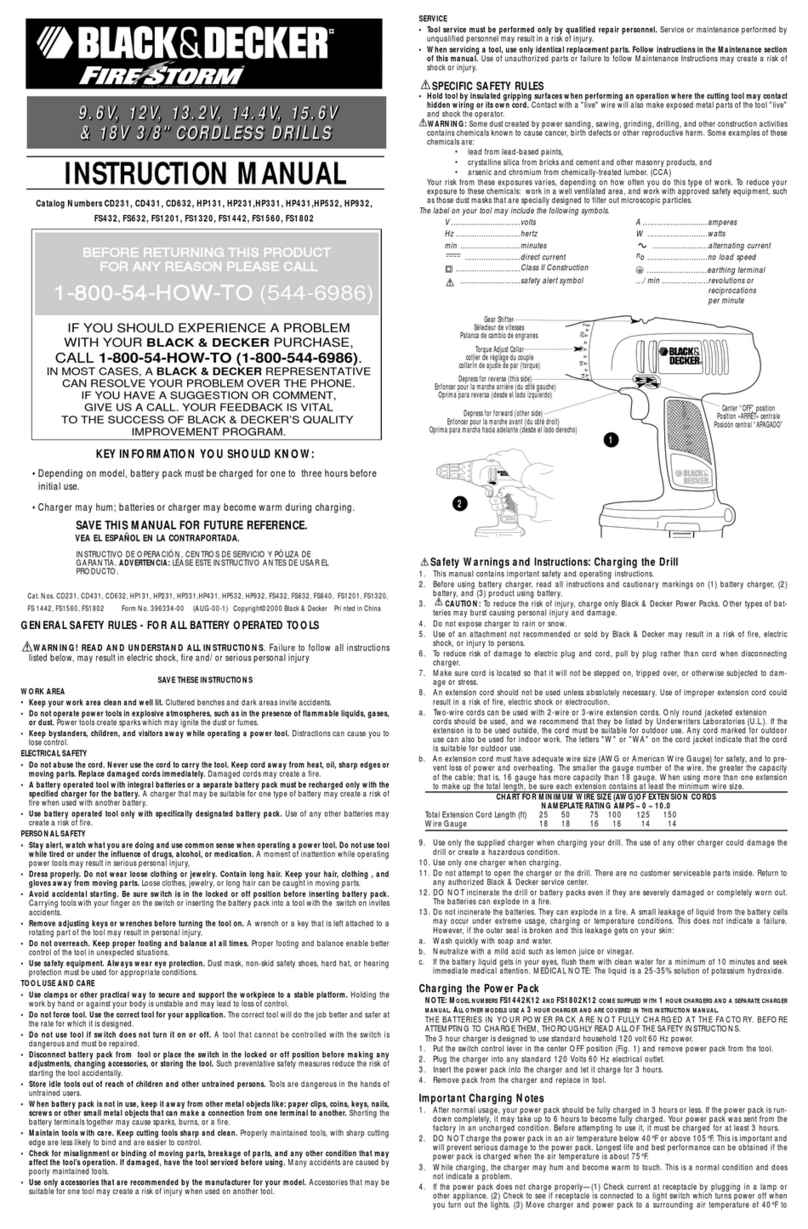
Black & Decker
Black & Decker Fire Storm CD632 instruction manual

Cooper Tools
Cooper Tools Quackenbush 120SC-112 Operation & service manual
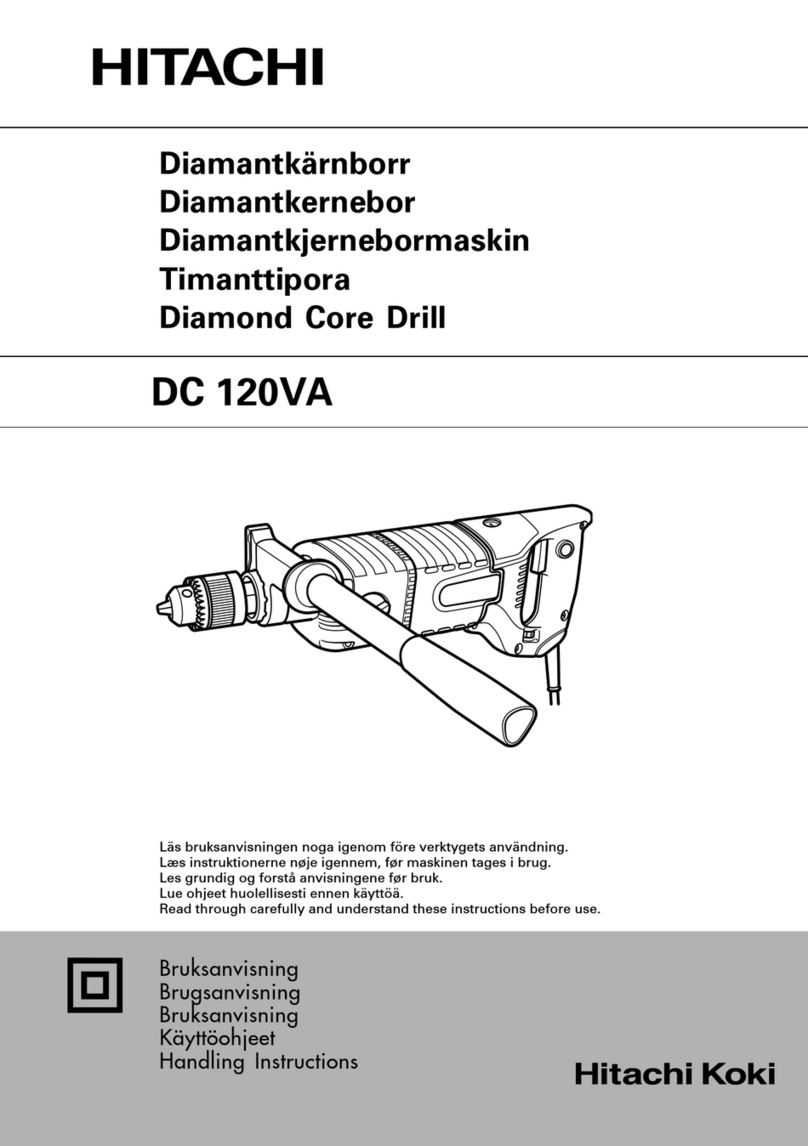
Hitachi
Hitachi DC 120VA Handling instructions
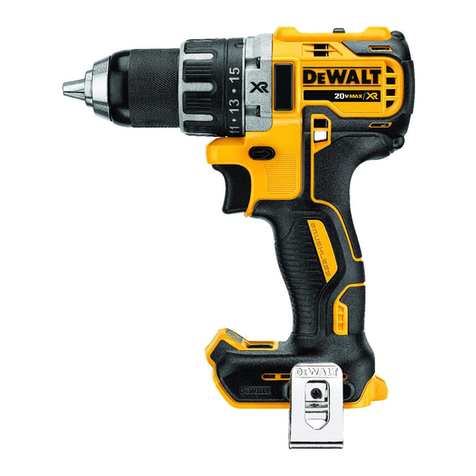
DeWalt
DeWalt DCD791B instruction manual
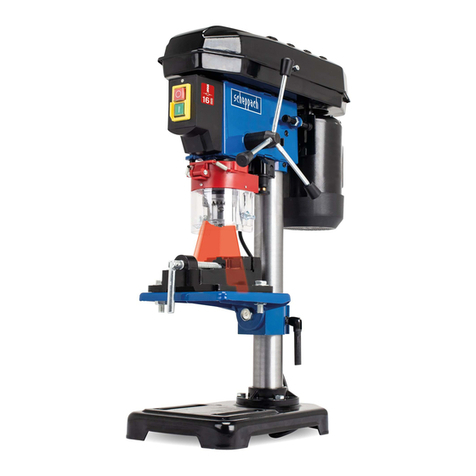
Scheppach
Scheppach DP16VLS instruction manual

